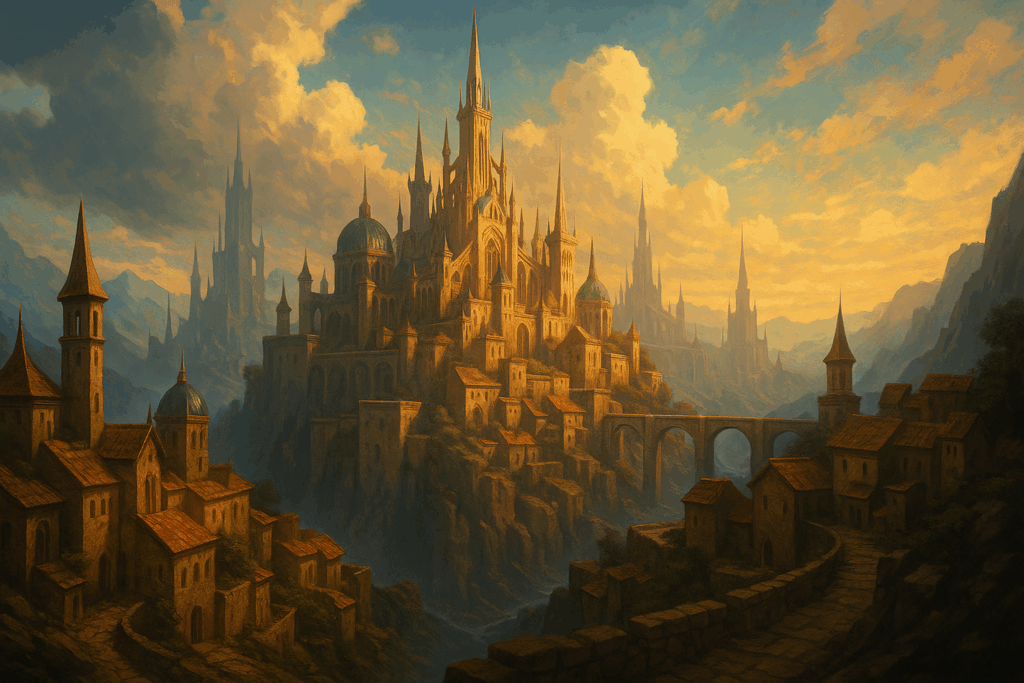World building is one of the most exciting parts of writing fantasy, sci-fi, and even historical fiction. You get to create kingdoms, cultures, magic systems, and histories entirely from scratch. It’s exhilarating, until you realize you have no idea where you put those three pages of notes about your fictional currency system. Or you can’t remember if your capital city was called Silverhold or Silverrun. This is why organization when it comes to world building is a key element of the writing process and why today, I’ll be teaching you how to keep your world building organized the easy way.
(Affiliate disclaimer: some of the links in this post are affiliate links which means that I earn a small commission at no additional cost to you when you purchase something through one of my links).
Why Organization Matters in World Building
Before we get into the how, let’s talk about the why.
When you’re building an entire world, even a relatively small one, you’re dealing with a massive amount of information. Geography, history, cultures, languages, religions, political systems… all of it stacks up quickly. Tiny details that seem minor early on can have major impacts later in your story.
At first, you might think you can just commit all of the information to memory or you might just jot down ideas on a random piece of paper and stuff that in a drawer somewhere. However, as your story grows, so does your world. Little inconsistencies can slip in. Town names change between chapters. Magic systems contradict themselves. Important cultural details get lost. This can really make your editing process harder and it can make or break the reader experience.
New to world building? Get started here → The ULTIMATE Beginner’s Guide to World-Building: Basics and More!
Disorganized world building doesn’t just cause confusion for readers, as it can cause frustration for you. It can slow down your writing, force constant backtracking, and even lead to major plot problems down the road.
Keeping your worldbuilding organized saves you time, strengthens your story, and allows you to dive deeper into your world without getting lost. Plus, it gives you the confidence to explore bold new ideas without fear of losing track of the ones you already built.
Start With a Central Hub
First things first: you need a central place where you keep all your worldbuilding notes.
This can be a physical notebook, a set of Word documents, or (even better) a dedicated world building tool.
The goal is to have one place where you can access everything. No more digging through random folders labeled “New Fantasy World 1,” “New Fantasy World FINAL,” and “New Fantasy World FINAL2REVISED.” Trust me, on occasion, I have done this or I’ve thrown ideas into my notes app on my phone and then into a notebook or maybe three notebooks with each one having some new vital piece of information. Not a good system, turns out!
A few programs that are absolutely fantastic for this include:
- World Anvil: This tool is designed specifically for worldbuilders. It allows you to create articles for countries, characters, cities, magic systems, and more. You can link them together like a wiki, making navigation incredibly easy. World Anvil also has timeline features for tracking historical events and family trees for your characters. Check out my review on World Anvil here!
- Campfire Writer: Campfire is a beautiful, modular worldbuilding platform. You can create sections for magic systems, technology, character profiles, religions, and timelines. It’s visually clean and easy to use, and you can pick the modules you actually need. You can also read my review on Campfire Writer vs World Anvil to get a better idea of how this tool works.
- Scrivener: Although Scrivener is primarily a writing tool, it’s fantastic for organizing worldbuilding. You can create folders, subfolders, notes, and research sections all within your project. It’s a great choice if you want your worldbuilding and story drafts to live in the same place. I’ve got an in-depth review on using Scrivener for writing books, so be sure to check that out.
For other options, you can check out this post where I break down my favorite world building tools!
The nice thing about having a central hub for world building is that everything you create is just connected, neat, and easy to find and use. You don’t need to keep trying to find random information in random places and take up more time searching rather than writing.
If you’re a pen-and-paper fan, you can create a similar system with binders, dividers, and color-coded tabs. Check out this post for some cool notebooks you can use for world building projects.
Divide and Conquer: Categories Matter
When you’re setting up your world building documents or hub, categories are your best friend.
Instead of dumping everything into one massive file called “Worldbuilding Notes,” break your information into sections. Some categories you might want to use include:
- Geography (maps, cities, climate zones)
- History (major wars, rulers, historical events)
- Cultures and Societies (traditions, languages, values)
- Magic Systems (rules, limitations, abilities)
- Religion and Mythology (gods, rituals, belief systems)
- Economy and Trade (currencies, goods, trade routes)
- Politics and Governance (laws, rulers, political factions)
- Technology (inventions, transportation, weapons)
- Flora and Fauna (plants, animals, magical creatures)
You can add as many categories as your world needs. The more specific you can be, the easier it will be to find what you need later.
In World Anvil, you can set up categories and subcategories easily. In Scrivener, create a main folder for each topic, with subfolders for individual entries.
Having well-labeled sections prevents important details from slipping through the cracks and helps maintain consistency across different parts of your world.
Use Templates (But Don’t Get Stuck in Them)
Templates are lifesavers when you’re world building. They prompt you with the right questions and help you sort of just fill in the details without you needing to think too much about it.
Many world building tools offer pre-made templates that you can use or you can make your own templates that you can just copy and paste to use whenever you need them.
However, a quick word of caution: don’t feel like you have to fill out every section of every template. Templates are tools, not homework assignments. Focus on the details that actually matter to your story.
For example, if the specifics of a country’s tax policies never come up in your novel, you don’t need a full page dedicated to it. You can briefly mention some elements that aren’t so important to your overall story. Use templates to guide your thinking and not to overwhelm yourself with endless lists.
Consider tweaking templates for your own use, too. Create short versions, focus only on essential elements, or add sections that suit your world’s unique features.
Keep a Master Timeline
If your world has lots of historical depth—wars, migrations, inventions, political changes—you 100% are going to need a timeline.
Timelines help you keep major events consistent. They also allow you to understand cause and effect in your world’s history.
You can build a timeline by hand, but tools like World Anvil and Campfire Writer have dedicated timeline features that let you easily add events, dates, and descriptions.
When you’re writing your actual story, you can refer back to your timeline to check when important events happened, how long ago a war was fought, or how old certain characters are.
Additionally, a timeline can spark new ideas for prequels, short stories, or side plots based on your world’s history. It’s a creative tool as much as an organizational one.
I sometimes also like to create a timeline on a piece of paper and then fill in details as I go while creating full documents for that timeline in something like Scrivener.
Use Tags, Cross-Links, and Visual Connections
Another trick to keeping your world building organized is using tags and links between your entries. If you’re building a kingdom and mention a city in the description, link that city’s entry so you can quickly jump back and forth.
World Anvil is especially good for this as it works like a personal wiki, allowing you to cross-reference different articles.
Tags can also help you filter and find specific types of information. For example, you could tag all your entries about cities, or all the ones about magic users.
Cross-linking keeps your world feeling connected and makes navigation way easier when you’re deep into your third rewrite.
Color-Code or Visualize Your World
If you’re a visual thinker, colors and diagrams can be a game-changer. Sometimes, seeing things laid out visually helps you spot gaps, overlaps, or inconsistencies that wouldn’t be obvious in a wall of text.
Consider sketching rough maps or family trees to accompany your written notes. These don’t have to be perfect, and they just have to help you understand the bigger picture.
Sometimes, I like to highlight certain elements in a specific color within a document which allows for me to easily understand what I’m talking about. Other times, I like to create sketches or generate images that relate to the element I’m talking about, as it gives me something visual to go off of when I’m imagining my story.
Set Aside World Building Time
It’s easy to fall into the trap of “only” worldbuilding without actually writing your story and sometimes, the world building aspects are more enticing than the writing aspects.
To avoid getting stuck, set aside specific time slots for worldbuilding. Maybe 30 minutes before a writing session, or a few hours once a week. During these times, update your files, add new details, and organize new information you’ve discovered while drafting. Keeping it regular prevents your notes from becoming a disorganized mess later on.
If you’re using a program, make sure to back up your data periodically someplace safe. You don’t want months of detailed worldbuilding to disappear because of a technical glitch. Or even print out some of the things that you’re generating and place them into a world building binder for yourself to keep paper notes in case you also like to do that.
Conclusion
There’s no one correct way to organize your worldbuilding. Some writers love detailed wikis with hundreds of pages. Others prefer a single well-organized notebook.
What matters is that you create a system you can actually use. One that helps you find what you need quickly and gives you confidence in the depth and consistency of your world. It has to work for you and it has to be something that makes sense to you. If you feel that you need to use more than one medium for this, then go right ahead. At the end of the day, you know your organizational style more than anyone else will.
Keep in mind though that world building should be inspiring and not overwhelming. Organizing is not required, but it can help make the process 10x more enjoyable.
Before you head on out, be sure to check out my series, The Fallen Age Saga and don’t forget to sign up for my newsletter so that you can stay up to date with all the biggest changes and updates on my page. There’s some big stuff coming soon, so you don’t want to miss out on that!

